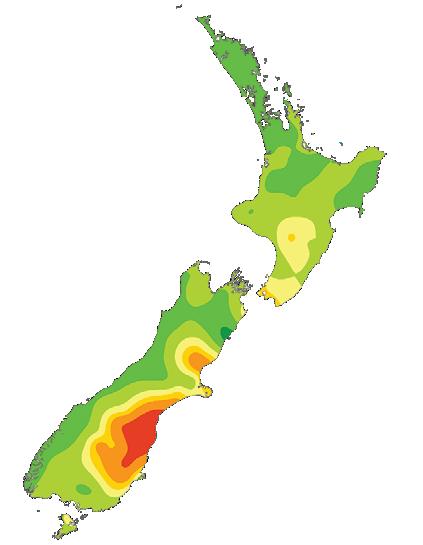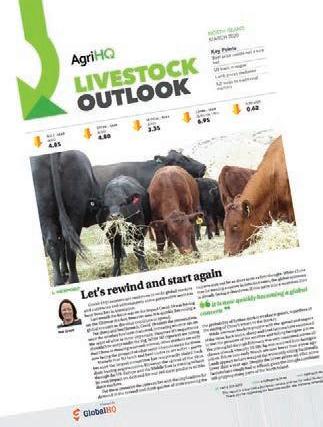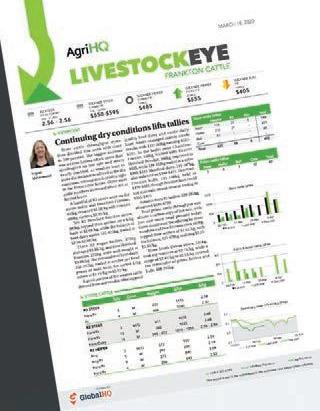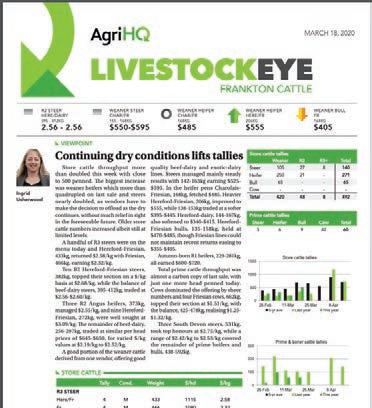
24 minute read
Weather
Overview
The early spring pattern continues with low pressure smothering New Zealand on Monday but then the usual windy sou’westers kick in behind it. The week ahead will be cooler than last week with our winds this week mostly from the south west, coming out of the Southern Ocean/ south of Australia region (the opposite of the sub-tropical nor’easters we had in many places last week). In saying that, the windier weather will keep overnight lows up with frosts less likely in the earlier part of this week. However, later this week high pressure expands again from the west, bringing colder nights, lighter winds and drier skies. Next week, looks spring-like with more windy westerlies and highs centred further to the north.
Soil Moisture 20/08/2020
Source: NIWA Data
Highlights
Wind Winds this week lean south to south west, tilting more westerly later in the week/weekend. While a little blustery at times in exposed areas nothing too significant is currently showing up. Winds mainly cooler in the west but milder in the east.
14-day outlook

Temperature
Cooler this week compared to last week for many regions as winds swing from sub-tropical northerly quarter to coming out of the Southern Ocean. With high pressure coming in later this week (bringing lighter winds) expect some frosts in the south around then.
Highlights/ Extremes
While Monday this week kicks off with low pressure smothering NZ, this time next week it will be high pressure pushing back in – meaning as we end August and start September, westerlies are likely with drier weather in the north and east.
7-day rainfall forecast

Pulse
Good season for SI prime lambs
William Hickson williamhickson@globalhq.co.nz
THE decent season for lamb at the South Island sale yards has continued in the leadup to new season lamb supply coming online soon.
The yards covered by the AgriHQ LivestockEye reports – Temuka, Canterbury Park and Coalgate – are typically a popular outlet for prime lambs, and until lockdown this year throughput through these yards was 5% higher than 2019. Although there was a slight increase in volume at the first post-lockdown sales, volume since then has realigned with the past year.
That lack of significant volume is creating a strong procurement competition between processors as the South Island lamb supply hit record lows a few weeks back.
Sellers are, therefore, opting to take the sale yard route as premiums can often be made from the increased competition provided by multiple buyers needing to fill contracts. It is also one of the few outlets for the oversized lambs that would incur penalties if sent directly to the processors.
The median lamb price paid at these centres has hovered around the $150 mark in August thus far, with the Temuka sale on August 17 reaching all the way to $167.
The mild 2020 winter may be impacting these values by allowing lambs offered to have higher yield potential, especially if they were held on the property for longer than usual as a result of lockdown.
SI prime lamb median
While the current August prices are $5-$10 higher than the five-year average, they have started a more restricted curve upwards than usual as the number of oldseason lambs dwindles.
The median price each week has also been tracking higher than usual for this time of year, but prices for the heaviest pens during August have lagged significantly behind previous years.
Only one pen so far in August, at Coalgate on the 14th, has been able to reach $200.
During 2019, this level was reliably hit each week from the end of May through to the final week of December.
In contrast, during 2020 prices of $200 or above have only been achieved at a third of the sales since May and usually only by a handful of pens.
This reflects the lack of export markets that processors have for heavy lamb cuts – heavy lambs are only desirable to keep plant throughput up (i.e. to cover fixed plant costs) – so buyers are motivated to avoid these if other options are available.
At current auction prices, margins are tight for processors and they will be looking to reduce the rates they pay as much as they can in the short term.
That will see downwards pressure applied to prices promptly if they can secure enough supply. With this in mind, any prime lambs should be making a trip to the sale sooner rather than later, particularly as heavier carcass weights will become a problem for processors as production begins for the Christmas trade, whose specifications reward a lighter framed animal.
The 14-day outlook locks in what we already pretty much knew: spring weather has arrived early. The days are, generally, milder than normal and rainfall recently has been back to normal in dry areas (like Auckland). However, the theme over the next 14 days is to transition away from low pressure and to be in the halfway mark for the next week (windier westerlies). But high pressure returns into early next week, especially northern areas, encouraging more southern westerlies.
0 5 10 20 30 40 50 60 80 100 200 400

The bulk of the wet weather coming up will be in western areas of both islands but the low on Monday to kick off this week. We will see some eastern wet weather for a time too. Keep up to date with our online rainfall accumulation maps here: www.farmersweekly. co.nz/weather – updated twice daily.

Weather brought to you in partnership with weatherwatch.co.nz
GET THE EDGE...
If you love the information you get from these pages, you will love AgriHQ’s livestock reports.



Livestock Outlook
For those who want to see and understand forecasting, this monthly report projects farmer operating prices six months ahead and supports these prices with analysis of supply/demand, procurement factors, key export markets and exchange rate effects.

Livestock Insight
Every week, we explain the context of the current market situation, drivers which are impacting the livestock markets and what to expect in the coming week.




LivestockEye
We create transparency for the industry with these independent, objective reports providing full sale results and informed commentary covering 10 sale yards across NZ that are emailed directly after the sale.
Demand for breeding ewe hoggets
The dry and drought conditions earlier in the year meant farmers in affected areas had to offload stock as feed and water levels diminished. Breeding ewe flocks were not immune and replacement ewe hoggets found themselves on trucks bound for the processors or sale yards. This has led to a small resurgence in demand for well-bred old season ewe lambs to purchase as replacement hoggets, as some farmers look to start rebuilding flock numbers.
COUNTIES Tuakau sales
• Hereford-Friesian steers, 477kg, made $3.00/kg • Autumn-born Hereford-Friesian steers, 90kg, fetched $505 • Well-conditioned Friesian cows traded at $2.10/kg to $2.44/kg
Prices for a yarding of 350 store cattle eased slightly at TUAKAU last week, PGG Wrightson agent Chris Elliott reported.
Heavy R2 steers, 450-588kg, traded at $2.85/kg to $3.00/ kg with 300-400kg at $2.70-$2.95/kg. R2 heifers, 400-511kg, returned $2.60/kg to $2.92/kg and 300-400kg, $2.70/ kg to $2.91/kg with autumn-born weaners, 98kg, $390. Wednesday’s prime market was firm. A small offering of steers traded at $2.92/kg to $3.07/kg, with heavy heifers earning $2.85/kg to $3.00/kg and medium, $2.85-$2.88/ kg. Medium cows managed $1.86/kg to $2.08/kg and light, $1.60/kg to $1.78/kg. Heavy prime lambs sold at $145-$185 on Monday. Medium primes fetched $125-$140 while good stores made $100-125 and medium, $70-$100. A small entry of ewes sold from $60 to $145.
BAY OF PLENTY Rangiuru cattle and sheep
• R3 Angus and Hereford-Jersey steers, 510-530kg, made $2.96- $3.00/kg • R3 Angus heifers earned $2.77-$2.86/kg • R2 Angus heifers, 324-372kg and run-with-bull, earned $2.45- $2.55/kg • 150 sheep were yarded with lambs $88-$145 and ewes $113-$140
The general tone of the sale at RANGIURU last Tuesday eased, but there was still plenty of bright spots. The R2 pens held predominantly heifers, which included HerefordFriesian, 287-341kg, at $2.76- $2.88/kg and Charolais, 255kg, $3.08/kg. Hereford-Friesian steers, 364-453kg, made $2.81/kg to $2.97/kg. while R1 Hereford-Friesian steers, 158-300kg, sold for $600-$920. Prime Hereford cows, 482-527kg, traded for $2.24-$2.27/kg with one pen, 593kg, at $2.39/kg. Only two pens of steers sold, and they were both very heavy. Hereford-Friesian, 717kg, returned $3.10/kg, and Angus, 681kg, $3.05/kg. Read more in your LivestockEye.
POVERTY BAY Matawhero sheep
• Top prime lambs fetched $185-$208 with the balance at $120- $135.50 • Prime ewes made $149 • Mixed-age Romney ewes fetched $118
There was a small yarding of store lambs at MATAWHERO last Friday where the top end of ewe lambs made $118- $126.50 and medium $91-$110.
WAIKATO Frankton cattle sale 18.08
• R2 Hereford-Friesian steers, 420-499kg, softened to $2.92-$2.99/ kg • R1 Hereford-Friesian steers, 236-283kg, improved to $3.30-$3.33/ kg • R1 Hereford-Friesian heifers, 187-289kg, eased to $2.90-$2.99/kg
Store cattle increased to 525 head for PGG Wrightson at FRANKTON last Tuesday, where local buyers had competition from Taupo and Raglan. R2 red HerefordFriesian steers, 397-497kg, were consistent at $2.87-$2.88/ kg. Angus-Friesian heifers, 320-385kg, fetched $2.75- $2.83/kg, and red Hereford-Friesian, 364kg, $2.79/kg. R1 Hereford-Friesian steers, 172-185kg, realised $2.73- $2.78/kg, and Angus-Friesian, 246-303kg, $3.11-$3.23/ kg. Charolais-Friesian heifers, 178-204kg, returned $2.81- $2.84/kg.
R1 Friesian and Friesian-cross bulls, 237-275kg, earned $2.32-$2.36/kg. Prime Angus-Friesian steers, 552-633kg, held at $2.91-$2.93/kg and Hereford-Friesian heifers, 466- 522kg, $2.86-$2.89/kg. Angus cows, 472kg, held at $2.30/ kg, while 410kg improved to $2.06/kg. Boner Friesian cows, 460-626kg, held at $2.20-$2.22/kg, with 475-520kg at $2.08- $2.17/kg. Read more in your LivestockEye.
Frankton cattle sale 19.08
• Quality R2 Angus steers, 314-364kg, improved to $3.12-$3.13/kg • R1 Simmental-Friesian steers, 285kg, were firm at $3.04/kg • R1 Hereford-Friesian heifers, 227-232kg, eased to $2.87-$2.91/kg
New Zealand Farmers Livestock penned just under 500 store cattle last Wednesday at FRANKTON. Seven R2 Hereford-Friesian steers, 314kg, reached $3.28/kg. Hereford-Friesian and red Hereford-Friesian heifers, 385- 418kg, strengthened to $2.89-$2.91/kg. R1 Angus-Friesian steers, 235kg, held at $2.87/kg with the balance of beefdairy, 136-290kg, mostly $2.91-$2.97/kg. Angus-Friesian bulls, 177-233kg, returned $480-$560 with Ayrshire-cross, 145-209kg, $300-$480. Top Friesian bulls, 282kg, sold well at $710, with lighter types $280-$460. Better autumn-born weaner beef-dairy heifers, 88-134kg, fetched $370-$465 and Hereford-Friesian bulls, 89-149kg, $400-$560. Well-marked Friesian bulls, 137kg, fetched $535. Prime steers, 476-668kg, held at $2.88-$3.00/kg, while Hereford-Friesian heifers, 414-461kg, strengthened to $2.91-$2.93/kg. Read more in your LivestockEye.
Waikato feeder calf sales
Friesian bull calves and most heifers came back at FRANKTON, TIRAU and TE AWAMUTU last week, however beef-cross bulls were steady to firm. Good Friesian bulls made $90-$160 though Te Awamutu reached $185-$215. Medium Friesian bulls made $45-$85 and small, $15-$40. Hereford-Friesian lifted to $270-$350, while medium and small held value at $200-$260 and $100-$190. Good Anguscross also improved to $180-$240 and Simmental-cross at Frankton made $290-$360. Heifers proved hard to shift and good Hereford-Friesian made $120-$220, while beef-cross of same size returned $70-$145. Medium Hereford-Friesian came back to $80- $110, while the balance of the heifers sold for $20-$60. Speckle Park-cross made $100-$120. Read more in your LivestockEye.
KING COUNTRY Taupo cattle sale
• R2 Friesian bulls, 376kg, sold well at $2.93/kg • R2 Hereford-Friesian heifers, 397-443kg, returned $2.77-$2.82/kg • Feature pens of R1 Angus-Hereford steers, 205-209kg, hit $4.04- $4.14/kg
Short-term cattle were the focus for a mainly local buying bench at TAUPO last Thursday. R1 steers also had a good sale and ranged from $3.58-$3.62/kg for 185-219kg, with heavier lines at $3.23-$3.42/kg. R1 heifers differed dependent on breed and quality, and Simmental, 222- 260kg, made $750-$780, with good weighted beef-Friesian also up to $700-$800 for varied $/kg. Lesser sorts were off that pace. Two pens of Friesian bulls, 224-255kg, sold for $2.61-$2.78/kg and good weighted beef-Friesian, 312- 325kg, $2.77-$2.89/kg. Read more in your LivestockEye.
TARANAKI Taranaki cattle
• Twenty in-milk dairy cows made $1000-$1600 • R3 heifers mostly sold at $2.70-$2.80/kg • R2 heifers earned $2.75-$2.85/kg • R1 Friesian bulls eased to $2.22/kg to $2.41/kg • Autumn-born weaner Hereford-Friesian heifers, 91-109kg, traded at $410-$440
There were just over 360 head of mixed-quality store cattle at TARANAKI last Wednesday. R3 steers mostly held and better-quality types achieved $3.05-$3.11/kg, with second cuts at $2.93-$2.99/kg. R2 Hereford-Friesian steers, 390kg, sold at $3.21/kg, although the bulk traded at $2.93- $3.03/kg. R1 steers were lighter and softened with HerefordFriesian, 146-188kg, back to $3.72-$3.84/kg, and Angus and Angus-cross, 185-185kg, $3.35-$3.39/ kg. Better heifers made $2.76-$2.83/kg. Friesian boner cows, 521-737kg, were well rewarded at $2.29-$2.31/kg, and two prime steers also sold well at $2.98/kg. Read more in your LivestockEye. • Most very heavy ewes eased to $140-$150 • Very heavy cryptorchid lambs strengthened to $179-$194 • Most very heavy ram lambs held at $181-$190 • Heavy mixed-sex lambs returned $135.50-$148.50
A moderate yarding of 880 sheep were penned at STORTFORD LODGE last Monday. The smaller ewe offering of 207 mainly eased though four top ewes held at $181 and nine very good types, $128.50. Good ewes softened to $106-$111, while lighter types held at $64-$85.50. Lambs numbered just under 650. Top males softened to $159.50, though 16 heavy types held at $145.50. Top mixed-sex lambs eased to $160-$165. Heavy to very-heavy ewe lambs earned $142-$163. A single Shorthorn bull, 675kg, was picked up for $2.20/kg, and three cows of the same breeding and 447kg, $1.90/kg. Read more in your LivestockEye.
Stortford Lodge store cattle and sheep
• R2 Angus & Angus-Hereford steers, 497-535kg, lifted to $3.40- $3.46/kg • R2 beef-cross bulls, 495kg, firmed to $3.12-$3.23/kg • Top R1 Angus steers, 295-316kg, achieved $3.86-$3.96/kg • Most ewes with lambs-at-foot made $105-$110 all counted • Good ewe lambs improved to $120-$125
Spring sale mode hit STORTFORD LODGE last Wednesday, as 900 cattle were penned and 570 ewes with lambs-at-foot. Cattle buyers were selective and quality sold well but lesser lines were well off the pace. Several lines of R1 steers bettered $1100, though heifers were lighter, and most sold for $440-$695. Traditional in-calf cows varied from $2.30/kg to $2.83/kg. Old season lamb volume was high at 7700, but like the cattle results varied dependent on buyer tastes. Very heavy ewes and males held at $150-$174, though good types eased to $135-$145. Medium mixed-sex made $110-$126, and light ewe lambs, $40-$72. Read more in your LivestockEye.
MANAWATU Feilding prime cattle and sheep
• Friesian cows, 473-483kg, provided the bulk of the cattle at $2.11- $2.18/kg.
The morning started with a frost at FEILDING last Monday. Lamb prices continued their good run with very heavy types $182-$195. Heavy lines provided the majority at $159-$179 and medium-good lambs made $136-$158. Ewe volume and quality reflected the time of year and the heaviest two in good condition made $141 and $147 respectively, though the balance lacked any real quality and sold for $90-$124. Read more in your LivestockEye.
Manfeild Park feeder calf sale
The Monday sale at MANFEILD PARK yarded 405 head. Friesian bulls eased but good beef-cross held value. Top Friesian reached $100-$150, medium $50-$80 and small, $20-$40. Hereford-Friesian reached $250-$300, with medium and small, $100-$220. Other beef-cross returned $100-$190, though Belgian Blue-cross topped the sale at $410. Heifers eased and the top beef-cross lines across all breeds made $140-$185, while medium fetched $100- $130. Small calves made $60-$80. Read more in your LivestockEye.
Feilding store sale
• Traditional steers, 415-565kg, made $3.20-$3.25/kg • One large pen of 435kg Angus R2 heifers jumped to $3.30/kg • R1 traditional steers, 225-275kg, eased to $3.70-$3.80/kg • Ewes with LAF mostly made $101-$116 all counted • Ewe lamb average held at $124
Another marathon cattle sale saw most sections sell for similar values as the week before. A lot of the R2 steers were 340-560kg Hereford-Friesian, with clean-marked lines making $2.85-$3.05/kg. Six big pens of 395-515kg Friesian bulls all made $3.00-$3.05/kg. Traditional R2 heifers, 325-475kg, were mainly strong selling at $3.15-$3.20/kg. Traditional R1 steers centred on $3.75/kg. Light Friesian bulls held around $2.95-$3.05/kg but heavier cuts were often passed in. A moderate sheep yarding almost had more attention on the ewes than the lambs. Almost twenty pens of ewes with lambs-at-foot softened slightly. Good
DROUGHT IMPACT: Paul Sorensen, Kereru, purchased 271 Romney ewe lambs for $152 from Atua Farm, Elsthorpe. With top Hildreth genetics, he targeted these for replacement hoggets as his usual supplier had to offload earlier due to the drought.

to-medium types mainly made $101-$116 all counted and lesser types were $80-$90 all counted. In-lamb ewes were tough selling, with the better lines $160-$170 for all percentages. Good male lambs made $140-$150, mediums $130-$135 and $110-$120 cover the majority of the lighter cuts. Ewe lambs peaked at $140-$150, moving to $120-$130 on the mediums and $110-$120 for much of the rest.
Rongotea cattle
• R3 Hereford-Friesian steers, 865kg, made $2.64/kg • R2 Hereford-Friesian steers, 700kg, earned $2.81/kg • R2 Murray Grey-cross heifers, 408kg, sold at $2.28/kg • R1 Friesian bulls, 310kg, traded at $1.97/kg • Angus boner cows, 365-505kg, sold at $1.96/kg to $2.14/kg
Buyers were greeted by some welcome rain at RONGOTEA last Wednesday, New Zealand Farmers Livestock agent Darryl Harwood reported. R1 HerefordFriesian steers, 207-280kg, made $2.48/kg to $3.15/kg. Angus bulls, 297kg, managed $2.93/kg and HerefordFriesian heifers, 163-230kg, $2.22/kg to $3.49/kg. Weaner bulls and heifers sold at $340-$450. Friesian cows with calves-at-foot were bought for $960 all-counted with Angus at $1300, while in-calf Friesian made $1300 and crossbred $1280.
CANTERBURY Coalgate cattle and sheep
• Prime Hereford steers, 583kg, made $3.20/kg • Prime Angus steers, 596kg, fetched $3.18/kg
Prime Charolais and Charolais-cross heifers, 505-685kg, made $2.87-$2.92/kg • Ewe lambs provided half of the store section and earned $122- $144 • Other store lambs generally earned $110-$132
Most prime steers at COALGATE last Thursday were high-yielding types over 550kg that made $3.00/kg to $3.16/ kg with many 450-550kg lines closer to $2.90-$3.00/kg. Angus and Angus-cross heifers, 450-780kg, contributed half of the section and earned $2.75-$2.86/kg. The only pen of R2 steers was Hereford-Friesian, 375kg, $2.59/kg while same breed heifers and mixed-sex, 343-390kg, ranged from $1.87/kg to $2.31/kg. R1 numbers were mixed in quality with Hereford-Friesian bulls and heifers, 131-248kg, priced at $350-$460. The sheep section was top heavy with prime ewes and those in good or medium condition traded for $100-$130 and heavier lines $135-$190. Heavy lambs earned $160-$191 and lighter types mostly $121-$159. Ewes with lambs-at-foot were entered and included a pen of 51 ewes and 47 lambs. These sold for $101 all counted, with smaller pens mostly $108-$117. Read more in your LivestockEye.
SOUTH-CANTERBURY Temuka prime cattle and all sheep
• High-yielding steers over 500kg were mostly priced at $2.81- $2.91/kg • Charolais-cross heifers, 620kg, pushed to $3.00/kg • Friesian heifers, 443-449kg, made $2.15-$2.24/kg • Consignments of heavy store lambs from the Chatham and Pitt
Islands made $135-$180
Boner throughput climbed at TEMUKA last Monday but there were also large entries of good beef cattle. Angus heifers, 545-599kg, traded at $2.87/kg to $3.05/kg while Hereford and Angus-Hereford, 480-528kg, were close behind at $2.97-$3.01/kg. Mid-range Hereford-Friesian, 435-505kg, averaged $2.74/kg, but red lines were $2.49/ kg. Angus and Angus-Hereford also featured in the cow pens and buyers paid $2.16-$2.19/kg for pens above 600kg. The top prime lambs reached $180-$181 and two-thirds of the tally earned $130-$179. The best ewes were $199 with heavy types $160-$198. Medium ewes provided most of the section and earned $109-$139. Mid-range store lambs earned $110-$141. Read more in your LivestockEye.
Temuka store cattle
• R2 Charolais-cross steers, 343-396kg, achieved $3.23/kg • R2 Simmental-Hereford steers, 403kg, managed $3.07/kg • R2 Hereford-Friesian bulls, 333kg, sold for $3.01/kg • R1 Charolais-Simmental steers, 247-288kg, made $880-$925
Most buyers were after short-term cattle at TEMUKA last Thursday. Close to 50 R2 Hereford-Friesian steers, 410-480kg, improved to earn $2.75-$2.86/kg, whilst a consignment of Hereford, 329- 375kg, made $2.65-$2.74/kg. Plenty of Chatham Islands Red Devon bulls sold very well at $2.83/kg to $2.96/kg. Traditional heifers, 350-365kg, firmed to average $2.65/kg while dairy-beef types, 360-415kg, also improved to $2.50-$2.59/kg.
Buyers had plenty to choose from in the R1 pens, but they were not as popular as older cattle. The steer pens were mostly beef-cross that made $450- $680. Heifers outnumbered bulls and steers 2:1 but were generally lighter than their male counterparts.
Murray Grey heifers, 208-264kg, made $505-$650, while Hereford-Friesian over 200kg sold for $540-$590. Read more in your LivestockEye.
OTAGO Balclutha sheep
• Heavy prime rams made $70 • Top store lambs fetched $110-$125, with medium $90-$100 and small $60
A small yarding of prime lambs was penned at BALCLUTHA last Wednesday, which sold on a steady market with heavy types at $150-$170, medium $130-$140 and light $120. Prime ewes were limited, and heavy firmed to $150-$170, with medium $120-$130 and light $80-$90. Five-shear Romdale, unscanned in-lamb ewes featured and earned $180, while a line of Romney ewe hoggets returned $148.
SOUTHLAND Lorneville cattle and sheep
• R2 Angus steers and heifers, 4017-416kg, traded at $2.78-$2.81/ kg • Better boner cow made $2.00/kg, with lighter types at $1.54/kg to $1.70/kg • Top store lambs firmed at $95-$110, with light to medium $65- $90 • Heavy prime ewes strengthened to $138-$158, with medium $102-$121 and light $70-$97 • Local trade rams fetched $92-$96
There was a small yarding of prime cattle at LORNEVILLE last Tuesday. Good steers, 650-710kg, fetched $2.60-$2.66/ kg. A moderate store cattle offering included R1 Murray Grey-cross and Hereford-cross steers, 211-238kg, at $2.80-$2.82/kg, whilst Friesian bulls, 290-300kg, fetched $2.59-$2.67/kg. Good R1 Murray Grey heifers, 238kg, sold at $2.82/kg, while Hereford-cross, 164kg, were $2.44/kg. Heavy prime lambs eased slightly to $151-$178, with light to medium $106-$140. Good-quality two-tooths returned $132. Ewes with lambs-at-foot were earned $95 all-counted and lighter mixed-age Romney ewes, scanned-in-lamb traded at $150.
Charlton sheep
• Heavy prime ewes eased to $140-$150, medium $115-$130 and light $80-$100 • Heavy local trade rams earned $70
There was a medium sized yarding at CHARLTON last Thursday where prime lambs earned $150-$175, medium $130-$145 and light $120-$128. The top end of a very small yarding of store lambs fetched $115, with light to medium at $80-$90.
Where livestock market insights begin



LivestockEye
• LivestockEye reports provide full sale results and informed commentary and is emailed directly after the sale. • The most comprehensive and independent sale report you can get your hands on. • Only AgriHQ sample-weighs store lambs to give you $/kg
LW benchmark pricing. • Choose from 10 sale yards across the country or check out our other popular reports.
Be ahead. Be informed. Be a subscriber Head to agrihq.co.nz email info@agrihq.co.nz or call 0800 85 25 80
5.10 7.25 4.15
R2 TRADITIONAL STEERS, 465KG AVERAGE, AT STORTFORD LODGE ($/KG LW)
3.28
high lights
R2 Red Devon bulls, 279-420kg, at Temuka
$130-$180
Most South Island prime lambs
Home cooks targeted
Neal Wallace neal.wallace@globalhq.co.nz
MEAT companies are changing portion sizes and targeting midweek meals as they switch products from food service to chilled retail markets.
Farmers Weekly last week reported the demise of food service markets around the world due to the global covid-19 pandemic forcing meat companies to divert product away from traditional frozen and food service markets.
AgriHQ senior analyst Mel Croad says any increase in chilled meat volumes is welcome.
“Any lift in the volume of chilled product is a win-win for both exporters and producers, but in the current economic climate it may be a hard ask to gain further traction beyond what is already being achieved,” she said.
Sales of chilled product make up about 12% of New Zealand’s annual 780,000 tonne lamb and beef exports.
Croad says the proportion of chilled lamb exports between October and December last year was about 20% of total lamb exports and the five-year average over those three months is 26%.
The long term average is lower for beef with the proportion of chilled beef at 6% of total beef exports over a 12 month period.
“There is still a significant reliance on frozen which may hamper the ability to push up volumes of chilled exports,” she said.
Croad says making a switch to chilled requires relationships with customers and access to chiller space.
Meat companies say they are responding to growing demand from consumers forced by government lockdowns to cook at home.
Alliance Group sales manager Shane Kingston says to compensate for the lower consumption from the food service sector, it has been working with
CONSUMER NEEDS: Meat companies say they are responding to growing demand from consumers forced by government lockdowns to cook at home.

its partners to place more product into retail and online.
“We have been also re-balancing our portfolio of supply into other markets and changing product specifications so that we have the right products for the various markets,” he said.
“We continue to develop consumerfacing programmes with our global retail customers and have been increasing our chilled volumes because this is what consumers are seeking during the pandemic.”
Consumers want healthy and nutritious quality NZ red meat.
“As with any key trading period, retailers do provide additional chilled space to support a strong programme,” he said.
“Freight availability via sea is continuing in line with normal levels.”
Last year, Silver Fern Farms (SFF) took a major step into retail by supplying red meat retail packs to 14 Fairway Market stores in the US Tristate area, New York, New Jersey and Connecticut.
This complemented existing supply arrangements to local butchers and restaurants.
SFF is also working on retail opportunities in the China market.
It recently made its range of retail red meat products available to NZ consumers through a partnership with e-commerce retailer Gourmet Direct.
Group marketing manager Nicola Johnston says the partnership with Gourmet Direct was a natural fit given the growth of online shopping following the covid-19 lockdown.
Orders are filled overnight and Johnston says it also provides the company with market and product information.
Its retail packs will continue to be available through existing retail outlets and come trimmed and in serving portions.
ACROSS THE RAILS -
SUZ BREMNER
A TRICKLE of ewes with lambs-at-foot turned into a flood at Stortford Lodge, as they made their annual pilgrimage down from their hill paddocks of northern Hawke’s Bay.
Sitting alongside Feilding, these two yards cumulatively offer up the biggest supply of this class nationwide and at Stortford Lodge 2700 ewes and 3600 lambs graced the pens from August to November in 2019. This was on the low side compared to other years, though, as more paddock sales were completed. In 2017, tallies totalled just over 6000 ewes and 8500 lambs at this yard.
There are a few extra buyers looking into this market this year which has given it a boost, not that it needs one given it is a niche and quite lucrative anyway.
The regular purchasers have been joined on the rails by out-of-towners from further south, who have a bit of feed up their sleeves and are keen on the smaller outlay that this class offers.
Also elbowing in are local farmers who had to make the tough decision to cull breeding ewes because of the drought and are now looking to get lambs on the ground to keep the farming systems ticking over.
With each different buyer comes a different set of preferences and that can make this market a hard one to judge.
Docked lines are looked upon more favourably than lines that are yet to meet the docking crew, but the majority of those offered still have that task ahead of them.
Older lambs take precedence over lambs that are under two weeks old and, more often than not, lines with a lower ewe-lamb ratio are targeted over a line that is teeming with lambs.
Ewe condition also has a significant impact and this year rearing lambs has not been an easy task for the girls given what the season has thrown at them.
To date, this year’s market for similar conditioned ewes is trailing 2019 levels only by $5-$10, with most still managing to sell for $105-$110 all counted.
There is opportunity to buy lines priced either side of that level, though $80 seems to be the floor and only a select few have exceeded $120.
suz.bremner@global.co.nz
Find out more about AgriHQ at agrihq.co.nz


TURANGANUI ROMNEYS “Reliable performance you can count on”













